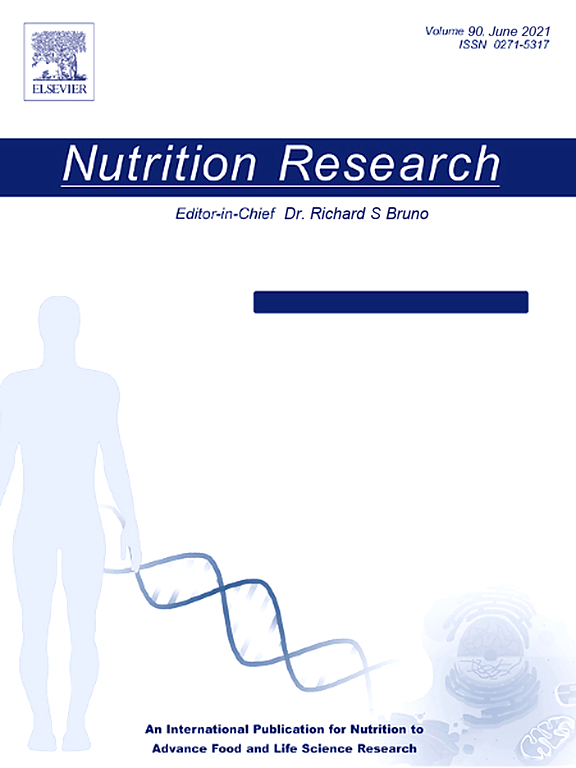Low dietary intake of marine n-3 fatty acids and seafood significantly contributes to metabolic syndrome burden in China
IF 3.1
3区 医学
Q2 NUTRITION & DIETETICS
引用次数: 0
Abstract
Marine n-3 polyunsaturated fatty acids (PUFAs) and seafood intakes have been shown to decrease the risk of metabolic syndrome (MetS), whereas data on related MetS burden in China remain absent. We hypothesize that low marine n-3 PUFAs and seafood consumption are a significant contributor to the burden of MetS in China. The time trend of marine n-3 PUFAs consumption and seafood was evaluated based on the China Health and Nutrition Survey. We used the comparative risk assessment method to estimate the population attributable fraction of MetS cases attributable to the low marine n-3 PUFAs and seafood consumption. We also projected the intakes of marine n-3 PUFAs and seafood and the related MetS burden from 2011 to 2031. The overall intakes of marine n-3 PUFAs (40.4 mg/day) and seafood (32.6 g/day) were far below the optimal level in 2011. The low intakes of marine n-3 PUFAs and seafood were estimated to be responsible for 8.1% and 2.2% of the MetS burden, accounting for 17.0 and 4.6 million MetS cases, respectively, according to the International Diabetes Federation definition in 2011. Although marine n-3 PUFAs and seafood intakes are projected to increase for the next 20 years, the intake levels would still be inadequate and are expected to contribute to 11.3 (marine n-3 PUFAs) and 2.2 (seafood) million MetS cases in 2031. Dietary guidelines should continue to highlight increasing marine n-3 PUFAs and seafood consumption to reduce the MetS burden in China.

海洋n-3脂肪酸和海产品的低摄入量是造成中国代谢综合征负担的重要原因
海洋n-3多不饱和脂肪酸(PUFAs)和海产品摄入已被证明可降低代谢综合征(MetS)的风险,但中国仍缺乏相关MetS负担的数据。我们假设低海洋n-3 PUFAs和海鲜消费是中国MetS负担的重要贡献者。根据中国健康与营养调查,评价了海洋n-3 PUFAs消费与海产品的时间趋势。我们使用比较风险评估方法来估计由于低海洋n-3 PUFAs和海鲜消费导致的MetS病例的人群归因比例。我们还预测了从2011年到2031年海洋n-3 PUFAs和海产品的摄入量以及相关的MetS负担。海洋n-3 PUFAs (40.4 mg/d)和海产品(32.6 g/d)的总摄入量远低于2011年的最佳水平。根据2011年国际糖尿病联合会(International Diabetes Federation)的定义,海洋n-3 PUFAs和海鲜的低摄入量估计造成了8.1%和2.2%的MetS负担,分别造成了1,700万和460万例MetS病例。尽管预计未来20年海洋n-3 PUFAs和海产品的摄入量将会增加,但摄入水平仍然不足,预计到2031年将导致1130万(海洋n-3 PUFAs)和220万(海产品)MetS病例。饮食指南应继续强调增加海洋n-3 PUFAs和海鲜消费,以减轻中国的MetS负担。
本文章由计算机程序翻译,如有差异,请以英文原文为准。
求助全文
约1分钟内获得全文
求助全文
来源期刊

Nutrition Research
医学-营养学
CiteScore
7.60
自引率
2.20%
发文量
107
审稿时长
58 days
期刊介绍:
Nutrition Research publishes original research articles, communications, and reviews on basic and applied nutrition. The mission of Nutrition Research is to serve as the journal for global communication of nutrition and life sciences research on diet and health. The field of nutrition sciences includes, but is not limited to, the study of nutrients during growth, reproduction, aging, health, and disease.
Articles covering basic and applied research on all aspects of nutrition sciences are encouraged, including: nutritional biochemistry and metabolism; metabolomics, nutrient gene interactions; nutrient requirements for health; nutrition and disease; digestion and absorption; nutritional anthropology; epidemiology; the influence of socioeconomic and cultural factors on nutrition of the individual and the community; the impact of nutrient intake on disease response and behavior; the consequences of nutritional deficiency on growth and development, endocrine and nervous systems, and immunity; nutrition and gut microbiota; food intolerance and allergy; nutrient drug interactions; nutrition and aging; nutrition and cancer; obesity; diabetes; and intervention programs.
 求助内容:
求助内容: 应助结果提醒方式:
应助结果提醒方式:


